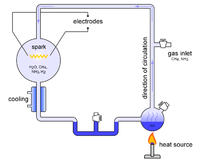
Photo from wikipedia
Supramolecular short-peptide assemblies have been widely used for the development of biomaterials with potential biomedical applications. These peptides can self-assemble in a multitude of chiral hierarchical structures triggered by the… Click to show full abstract
Supramolecular short-peptide assemblies have been widely used for the development of biomaterials with potential biomedical applications. These peptides can self-assemble in a multitude of chiral hierarchical structures triggered by the application of different stimuli, such as changes in temperature, pH, solvent, etc. The self-assembly process is sensitive to the chemical composition of the peptides, being affected by specific amino acid sequence, type, and chirality. The resulting supramolecular chirality of these materials has been explored to modulate protein and cell interactions. Recently, significant attention has been focused on the development of chiral materials with potential spintronic applications, as it has been shown that transport of charge carriers through a chiral environment polarizes the carrier spins. This effect, named chirality-induced spin selectivity or CISS, has been studied in different chiral organic molecules and materials, as well as carbon nanotubes functionalized with chiral molecules. Nevertheless, this effect has been primarily explored in homochiral systems in which the chirality of the medium, and hence the resulting spin polarization, is defined by the chirality of the molecule, with limited options for tunability. Herein, we have developed heterochiral carbon-nanotube-short-peptide materials made by the combination of two different chiral sources: that is, homochiral peptides (l/d) + glucono-δ-lactone. We show that the presence of a small amount of glucono-δ-lactone with fixed chirality can alter the supramolecular chirality of the medium, thereby modulating the sign of the spin signal from "up" to "down" and vice versa. In addition, small amounts of glucono-δ-lactone can even induce nonzero spin polarization in an otherwise achiral and spin-inactive peptide-nanotube composite. Such "chiral doping" strategies could allow the development of complementary CISS-based spintronic devices and circuits on a single material platform.
Journal Title: ACS nano
Year Published: 2022
Link to full text (if available)
Share on Social Media: Sign Up to like & get
recommendations!